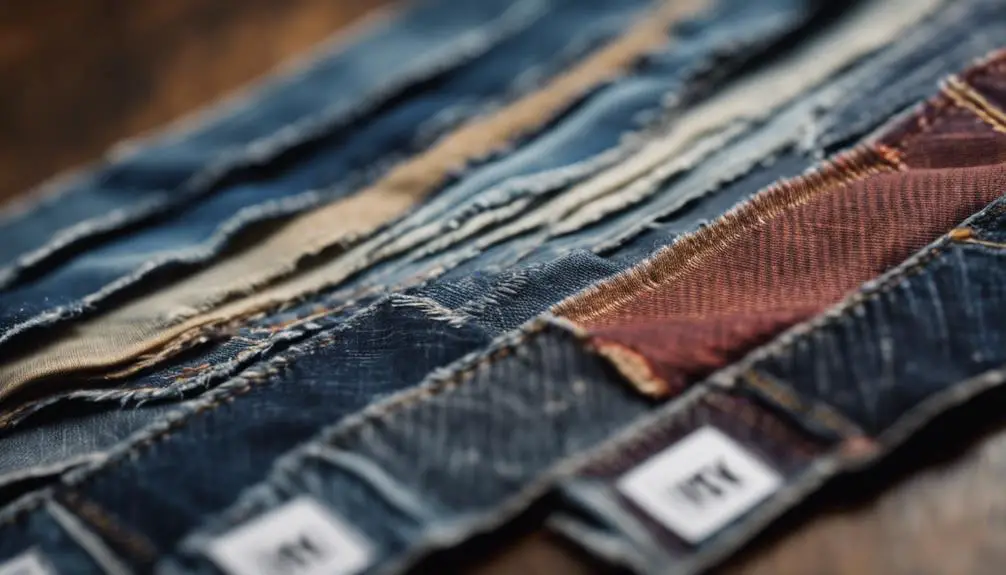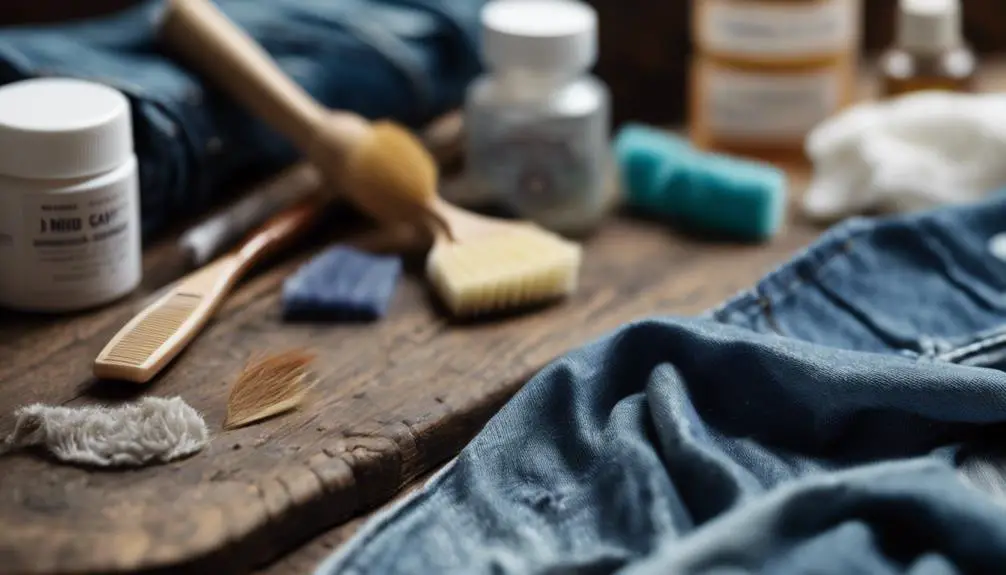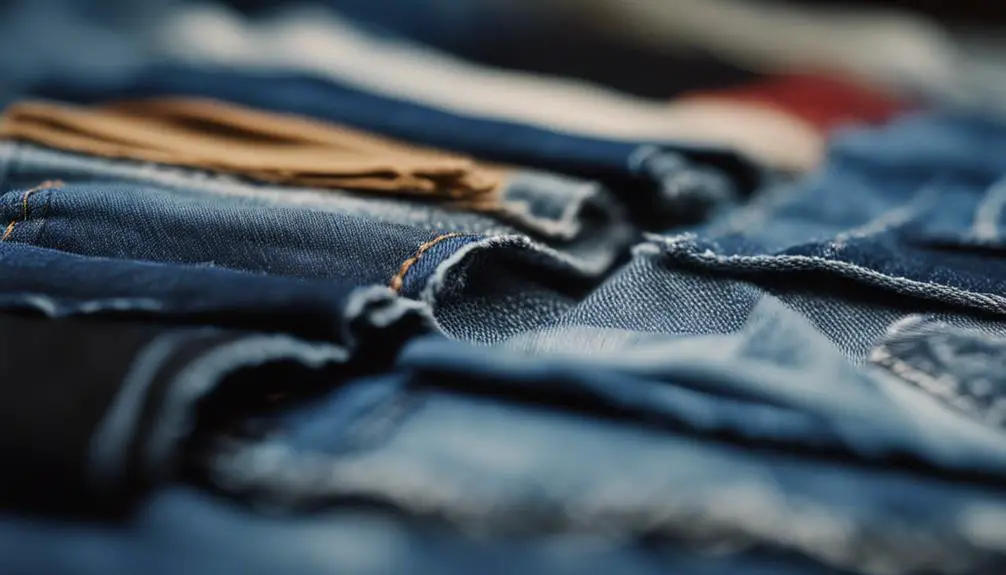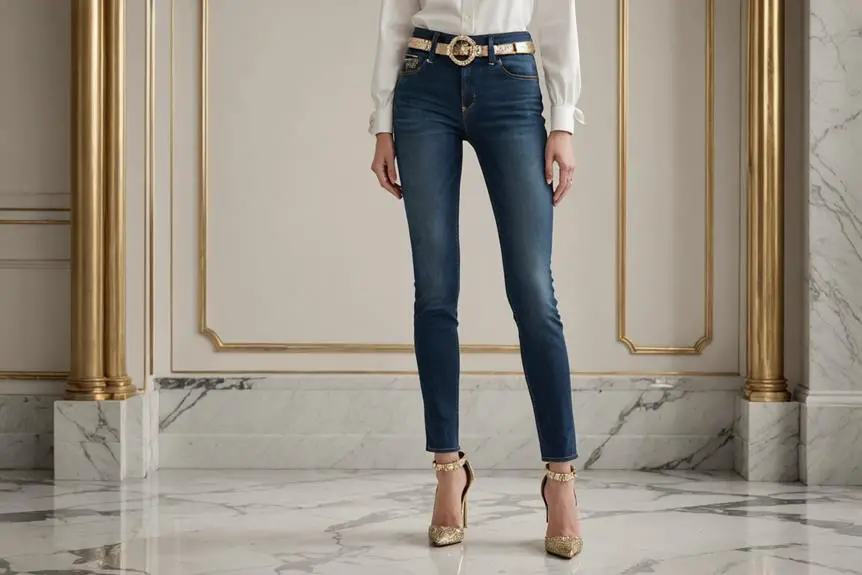To identify denim, start by examining its twill weave, characterized by diagonal ribbing. The fabric is usually indigo-dyed, giving it that classic blue color. Check the weight; sturdier denim typically weighs between 11 to 15 ounces. Look for selvedge edges and tight, symmetrical stitching, which signal higher quality. Remember, denim isn't just for jeans; it's also in jackets and skirts. Pay attention to the feel and texture affected by any washes or treatments. By understanding these features, you'll get better at spotting authentic denim. There's much more to explore about the nuances and styles of this versatile fabric.
Understanding Denim Basics

Denim is a unique fabric with a rich history and distinct characteristics that set it apart from other materials. This sturdy cotton twill fabric features a diagonal ribbing pattern, giving it a robust texture. Typically dyed with indigo, denim showcases that classic blue color that many people adore. One of denim's most notable qualities is its durability, which comes from its heavyweight construction, usually ranging from 11 to 15 ounces.
When you look closely at denim, you'll notice it's often made using a twill weave, where the warp yarn is dyed indigo while the weft yarn remains undyed. This technique creates that iconic two-tone appearance you recognize. The quality of denim can vary based on its composition; some are 100% cotton, while others may blend in materials like linen or elastane for added stretch and comfort.
After weaving, denim undergoes treatments like washing and bleaching. These processes can considerably alter the fabric's appearance, affecting its texture, color, and overall quality. Understanding these denim basics helps you appreciate the craftsmanship behind this timeless fabric, ensuring you make informed choices when selecting denim garments.
Differentiating Jeans From Denim
When it comes to clothing, many people often confuse jeans with denim, but they're not the same thing. Denim is a sturdy cotton twill fabric, known for its distinctive diagonal ribbing pattern. In contrast, jeans are trousers specifically crafted from denim fabric, usually featuring a recognizable five-pocket design.
You'll notice that denim isn't limited to just jeans; it's used in various clothing items, including jackets, skirts, and shirts. While jeans are primarily casual trousers, denim serves as a versatile fabric across multiple fashion categories. The weight of denim can range from lightweight (7-8 ounces) to heavyweight (19-21 ounces), affecting the durability and style of the jeans made from it.
Moreover, jeans often incorporate blends with other materials, like spandex or polyester, to enhance stretch and comfort. On the other hand, denim itself is typically 100% cotton or blended with other fibers for distinct characteristics. Fashion trends for jeans shift between styles and fits, like skinny or bootcut, while the fabric of denim remains consistent, proving its adaptability in the fashion world. Understanding these differences can help you make informed clothing choices.
Key Fabric Characteristics

The unique characteristics of denim make it a popular choice in fashion. Its sturdy cotton twill fabric, known for its diagonal ribbing pattern, contributes to both durability and a distinct texture. When you reflect on denim jeans, the classic indigo dye often comes to mind, but remember it can be produced in various colors and finishes.
One key aspect to take into account is denim weight, measured in ounces per square yard. Here's a simple breakdown:
| Weight Category | Ounces per Square Yard | Best Use |
|---|---|---|
| Lightweight | 7-10 ounces | Casual wear |
| Midweight | 11-16 ounces | Everyday jeans |
| Heavyweight | Over 17 ounces | Robust denim jeans |
The composition of denim can also vary, with options ranging from 100% cotton to blends that include spandex for added stretch. Additionally, selvedge denim features a self-finished edge that prevents unraveling, often produced on narrow-width shuttle looms, enhancing its quality and durability. Understanding these characteristics can help you make informed choices when selecting your next pair of denim jeans.
Recognizing Fashion Trends
Fashion trends in denim are constantly evolving, and keeping up with them can elevate your wardrobe. One prominent trend is distressed denim, which offers that vintage vibe with intentional rips and fades, perfect for a youthful look. High-waisted jeans have also made a strong comeback, flattering various body types while nodding to retro styles. If you're looking for something eco-friendly, consider the growing movement towards sustainable denim practices. Brands are increasingly focusing on raw denim and environmentally conscious materials, making it easier for you to shop responsibly.
Color trends change often, showcasing everything from classic indigo to vibrant hues and unique washes that reflect the current fashion landscape. Additionally, wide-leg and baggy jeans are reclaiming their place in the spotlight, influenced by 1990s and early 2000s fashion. These styles challenge the dominance of fitted jeans, giving you more options to express your personal style.
Proper Care Techniques

Keeping your denim looking fresh isn't just about choosing the right styles; it also involves proper care techniques. To maintain the quality denim you cherish, wash your jeans less frequently. Aim for every 5-10 wears, unless they're heavily soiled. This practice helps preserve the color and integrity of the fabric.
When it's time to wash, always use cold water. Hot water can lead to fading and shrinkage, diminishing the quality of your denim. Before tossing your jeans in the wash, turn them inside out. This simple step protects the outer fabric from friction and keeps colors vibrant.
After washing, skip the dryer. Air drying is the best option, as it prevents shrinkage and maintains the shape and fit of your jeans. If you're using detergent, choose a gentle formula specifically designed for dark fabrics. This helps enhance the longevity of your denim's color and texture.
Evaluating Denim Quality
When evaluating denim quality, you'll want to pay attention to several key factors that can make a significant difference in durability and appearance. First, consider the weight of the denim, measured in ounces per square yard. Heavier denim, typically 17 oz and above, is often preferred by enthusiasts for its toughness. Next, look for selvedge denim, which features a self-finished edge that prevents unraveling. This indicates a higher-quality fabric produced on narrow-width shuttle looms.
Also, examine the stitching quality. Symmetrical, tight, and non-frayed seams are signs of better craftsmanship and longevity. Don't forget to check the fabric composition; original denim should primarily consist of cotton. If you see blends with polyester or spandex, it might indicate lower quality unless you're specifically looking for stretch denim.
Identifying Original Vs. Replica

Identifying original denim from replicas can be a challenge, especially if you're not familiar with the key indicators of quality. When you're shopping for blue jeans, start by examining the materials. Original denim usually boasts robust construction and high-quality fabrics, while replicas often use lighter, less durable materials. This difference can affect the longevity of your jeans.
Next, pay attention to the stitching. Original jeans typically feature symmetrical, non-frayed stitching, showcasing meticulous craftsmanship. In contrast, replicas may have uneven or frayed seams, which can indicate poor quality. Another factor to evaluate is color durability; authentic denim fades gracefully with wear, while replica jeans might show noticeable fading after just one wash.
Don't forget to check the brand name on the label. Any misspellings can be a red flag, signaling that the jeans are likely replicas. Finally, if the jeans feel overly lightweight or show visible flaws, it's a clear sign they're not genuine original denim. By keeping these indicators in mind, you'll have a better chance of identifying quality blue jeans and avoiding disappointments.
Importance of Fit and Details
Finding the right fit in jeans is essential for both comfort and style. A proper fit balances the waist, rise, and leg opening, ensuring the waistband sits snugly without being overly tight. This attention to fit not only enhances your appearance but also prevents discomfort, greatly impacting the longevity of your jeans by reducing stress on seams and fabric.
Paying attention to details like tucked belt loops is important. They improve the overall look of your jeans and enhance durability by preventing fraying. Don't overlook the quality of hardware elements, such as rivets and buttons. Solid hardware contributes to the overall strength and longevity of your jeans.
Stitching quality is another critical detail. Look for symmetrical, non-frayed stitching, as it indicates higher quality construction. The care put into the stitching enhances both aesthetics and durability, ensuring your jeans last longer.
Ultimately, a well-fitting pair of jeans, combined with these important details, elevates your style while providing lasting comfort. By focusing on fit and these fine details, you can confidently identify high-quality denim that meets your needs.
Frequently Asked Questions
How to Tell if Something Is Denim?
To tell if something's denim, check for a sturdy twill weave and a diagonal ribbing pattern. Look for the weight; true denim feels heavier. A selvedge edge also indicates quality and authenticity in the fabric.
How to Identify Real Denim?
To identify real denim, examine the fabric's weight and weave. Look for tightly stitched seams and authentic branding. Notice how it fades over time; genuine denim develops a unique character that cheaper fabrics can't replicate.
How to Identify Quality Denim?
To identify quality denim, check the fabric composition for high cotton content, feel the weight for sturdiness, examine the stitching for consistency, and look for authentic selvedge edges that signify craftsmanship and durability.
What Is the Code for Denim Fabric?
The code for denim fabric is often ISO 15498, indicating its classification as woven twill. You'll find specific codes for weight and composition, like COT for 100% cotton or COT/EL for stretch denim.




